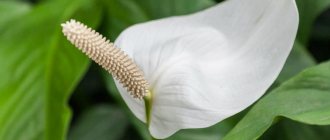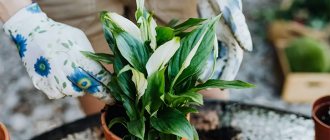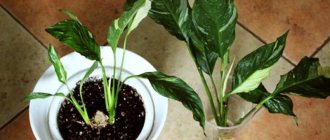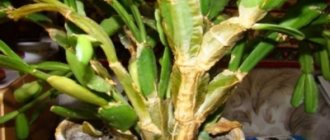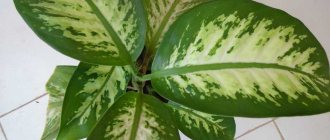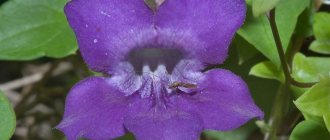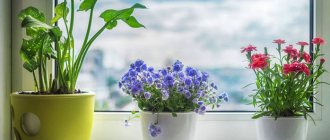- November 11, 2019
- Flowers
- Michael Michaelis
"Women's happiness", or spathiphyllum, is a fairly common indoor plant. This is due to its beauty and unpretentiousness. In our article we will talk about what the “female happiness” flower is, how to care for it so that it blooms, what fertilizers to add to the soil, how many times a week to water, and so on. This information will be especially useful for beginning gardeners. Although professionals will certainly be able to highlight several interesting points for themselves.
Watering rules
A rather moisture-loving tropical plant is what the “female happiness” flower represents. “How to care for it to bloom?” - a fairly common question among novice flower growers. However, professionals know that all tropical crops enter the flowering phase only if they receive enough moisture. The need for watering is indicated by the condition of the substrate. As soon as the top crust dries, it’s time to add water to the soil.
Despite the fact that the crop is moisture-loving, it should be watered with great care. The flower has an extremely negative attitude towards waterlogging, because this provokes the development of fungal infections inside the root system. To avoid accidentally overwatering the flower, you should carry out the procedure in small portions. As soon as you see that water has begun to accumulate in the pan, remove the watering can to the side. The drainage layer will also avoid waterlogging.
Many novice flower growers also ask the question: “The leaves on the “female happiness” flower are drying - what to do?” It is worth understanding that such a “symptom” is not always caused by insufficient watering. Sometimes the reason lies in dry air, and the gardener mistakenly begins to water the pot, which already contains a sufficient amount of moisture. To prevent this from happening, you should water the crop no more than 3 times a week in the summer and 1 time a week in the winter.
Step-by-step instruction
Before starting watering, be sure to prepare the water by settling and filtering. Also monitor her temperature.
- Test the soil. According to the rules, if the soil is wet, there is no need to water; if the surface is dry, then it’s time.
- Pour the pre-prepared liquid into a watering can with a long spout.
- Carefully water the flower, preferably so that the water does not get on the leaves. If the foliage or flowers do get wet, the moisture should be removed with a dry cloth.
- When the soil has darkened, then watering is completed.
- We drain the excess liquid from the pan, which is located under the flower pot.
- To saturate the soil with oxygen, be sure to loosen the top layer. A depth of 1 cm will be enough.
Soil for planting
Watering the “female happiness” flower (spathiphyllum) is far from the only issue that worries gardeners. After all, a plant just purchased in a store will first need to be planted somewhere. To do this, you need to prepare a high-quality substrate, which will consist of 2 parts turf soil, 1 part leaf soil, 1 part coarse sand and 1 part peat. It is also recommended to add 0.5 parts of crushed charcoal to the substrate. As an alternative, a ready-made substrate for aroid crops, which can be purchased in a store, is well suited.
It is also important to remember that the root system of spathiphyllum is extremely delicate, so only a substrate that has an airy structure is suitable for planting. Otherwise, the flower will grow very slowly. However, there is a little trick that will give the earthen mixture some airiness. You just need to add a little sawdust (not shavings) or ground brick. For every kilogram of soil there should be approximately 100 grams of this component.
How to propagate by cuttings?
The method of propagating anthurium by cuttings is very popular. Its essence lies in rooting a small part of a shoot cut from the green part of the plant. Cuttings can be carried out in three ways: leaf, apical and air-root. In the first case, a leaf acts as a cutting, in the second - the top of an adult shoot, and in the third - a cutting with aerial roots. It is worth considering these methods in more detail.
Sheet
Almost all types of anthurium can be propagated using the leaf method, spending a minimum of time and effort. To propagate a flower by leaf cuttings, a strong leaf with clearly defined veins is cut from an adult healthy plant. The length of the petiole should be from 3 to 5 cm. The leaf is tied into a vertical tube and placed with the petiole in a pre-moistened mixture of sand and peat, taken in equal parts. Usually 1/3 of the sheet is left above the ground surface, which is then covered with a jar.
The man-made greenhouse is placed in a warm and well-lit place, while trying to avoid direct ultraviolet rays, which through the glass of the jar can cause a burn to the cutting. It is necessary to ventilate and irrigate the plant and soil daily, and continue this until a young sprout appears from inside the leaf tube. This will mean that rooting was successful and the plant can be transferred to a general care regime. To do this, the jar is removed and the shoot is transplanted into a permanent container with pre-prepared soil.
As an alternative to the substrate, root growth can be done in water. To do this, the leaf is placed in water at room temperature with a root growth stimulator diluted in it, and no more than 4–5 cm of the leaf should be immersed in the liquid.
Airborne
Cuttings using shoots with aerial roots are one of the most effective propagation methods. It consists of the following:
- A strong shoot with several internodes and two leaves is cut from an adult healthy plant, after which the leaves are torn off, leaving only the petioles; this is done so that the forces of the young shoot are not used to feed the green mass, but exclusively to build up the root system;
- then the cuttings are planted in a sandy-peat substrate so that only aerial roots are in the ground, and the growth point remains above the surface;
- Next, the plant is irrigated with a spray bottle and covered with a bag;
- the greenhouse is moved to a bright, warm place, not forgetting to spray and ventilate the shoot daily; It is advisable to spray with slightly warmed water so that the plant steamed in the greenhouse does not experience stress from temperature changes.
Rooting of the sprout occurs very quickly. In a maximum of a week a new leaf should appear. After its appearance, the package is removed, the plant is transplanted to a permanent place and transferred to a general care regimen.
Apical
Propagation by apical cuttings is also a popular method and consists of the following:
- Using a sharp knife, cut off the top of the shoot and leave it for 15 minutes to dry the cut; the cutting should be exactly 12 cm long and have 2 healthy leaves;
- the shoot is placed in perlite and removed to a warm and bright place with a temperature not lower than +24 degrees;
- spraying is carried out daily.
The first roots usually appear after 3 weeks. After they grow to 3 cm, the plant is transplanted to a permanent place.
Important! Regardless of the method of reproduction, the cut sites on the mother must be disinfected. For more information about the propagation of anthurium by apical cuttings, see the following video
For more information about the propagation of anthurium by apical cuttings, see the following video.
Replanting after purchase
Many novice gardeners ask the question: “Why should I replant a plant I just bought, because it was in the store, which means it was grown under optimal conditions.” However, only those who do not know that store-bought soil is not intended for constant growth can think this way, since it contains a huge amount of nutrients that support the decorative appearance of the crop. However, if she is raised in such conditions for too long, she will definitely get sick. To transplant the “female happiness” flower (spathiphyllum), it is recommended to use the transshipment method.
- Carefully remove the flower from the pot along with the earthen lump.
- We place the flower in a new container, which is 2-3 cm larger than the old one.
- Add pre-prepared soil mixture to the container.
- Water the plant generously with settled or rain water.
Further care must be carried out with special care. To do this, it is important to look closely at indicators that signal a lack of nutrients, sunlight or water. However, it is worth understanding that if the flowers dry on the “female happiness” flower, then this is not yet a reason to sound the alarm and add growth stimulants to the soil. It’s just that in some cases it takes a culture a long time to acclimatize to new conditions. And the drying out of the buds is a completely normal reaction for the “female happiness” indoor flower. How to care for the crop? Read about this in the following sections.
Signs of nutritional deficiency
In spathiphyllum, like any other plant, nutrient deficiency is expressed in external changes.
Magnesium deficiency leads to growth retardation and external lethargy of the flower.
The leaves begin to gradually turn yellow or turn brown, but the veins retain their green color. These plants need fertilizing with magnesium sulfate.
From an overabundance of fertilizers, the leaves begin to dry out at the edges, and multiple black spots appear in the middle.
This is how the burn of the plant’s root system from overfeeding with nutrients manifests itself. Subsequently, the leaves dry out completely and fall off. Immediate replanting with mandatory washing of the rhizomes will help save the plant.
If the leaves turn yellow and begin to wither after abundant flowering, the plant needs complex feeding - it has expended all its strength on this process.
Liquid specialized fertilizers for aroids or transplanting into a larger pot with new nutritious soil will help solve the problem.
If the foliage turns yellow, but the veins remain green, this may also indicate iron chlorosis. Other variants of uneven yellowing usually come down to a deficiency of calcium and boron.
To solve the problem, spraying spathiphyllum with iron chelate (if iron chlorosis was detected) or preparations containing boron and calcium will help.
Small and pale leaves indicate starvation of the plant.
It is necessary to apply complex fertilizer to solve the problem.
Deficiency of phosphorus and potassium can be expressed in the absence of flowering (against the background of a general healthy condition).
Fertilizers should be limited to nitrogen-containing products, replacing them with potassium and phosphorus-containing ones.
A place to grow a flower “female happiness”
“How to care for it to bloom?” – this question can be seen quite often on various forums for gardeners, asked by beginners to professionals. The answer to this can be quite different, but most experts recommend that you first pay attention to choosing the optimal location for growing the crop.
It is best to give preference to a room that has a window facing east or west. It is also strongly recommended not to place a pot with a plant on window sills or balconies, where there is no additional source of shading. The culture loves sunlight very much and without it will never enter the flowering phase. But direct rays will burn delicate leaves, so in the summer you should use tulle or a special garden net, the shading level of which is 50%.
It is not recommended to place the culture in rooms with strong drafts, as this can provoke the development of a dangerous disease - powdery mildew. Although the flower still loves fresh air. So place the flowerpot on some high surface (there will be a draft across the floor) and be sure to close the window before you decide to spray. Otherwise, the drops of moisture on the leaves will cool, after which a white coating will begin to form on the plates.
Air humidity and swimming
Caring for “female happiness” at home also involves regularly spraying the leaves with a spray bottle. Tropical crops love moist air, so you will have to do this at least 3-4 times a week. You just need to set the tool to spray mode so that the droplets falling on the foliage are very small. If you don’t have time for frequent spraying, you can place a steam generator or a three-liter jar next to the flowerpot with expanded clay at the bottom (the stones will increase the intensity of liquid evaporation by almost 10 times).
To give the flower a decorative appearance, you can also start wiping it regularly with a sponge dipped in water. This procedure can be carried out every day in the summer and about a couple of times a week in the winter. It can also be replaced with a regular cold shower. However, don't overdo it with your bath! This should be done no more than once a month in the summer and once every 2 months in the spring and autumn. The water temperature for swimming should be at least 30 degrees Celsius.
Organic and mineral supplements
Don’t know what to feed the “female happiness” flower? Most professionals recommend using complex mineral supplements for this purpose, which contain nitrogen, phosphorus and potassium. In addition, when reading the composition, it is important to pay attention to the content of copper, manganese and iron in the preparation, since these microelements have a beneficial effect on the health of the crop and its growth rate. However, dilute the tablets or essence in water strictly according to the instructions, since an excess of components can be much more dangerous than their deficiency.
As for organic fertilizers, they are used only in extreme cases and exclusively by professional gardeners. If a flower lacks a certain microelement, for example, nitrogen, then professionals can dilute organic matter (manure, urea) to compensate for its deficiency. It’s just not advisable to use organic matter during the period of bud formation and flowering. In addition, without proper experience, you should refrain from using such fertilizers, since exceeding the dosage can simply kill the plant.
It is best to fertilize in the spring, when the plant begins to emerge from winter hibernation. It is important to dilute the fertilizing with water and then pour it directly under the root (some preparations have the ability to be sprayed on the leaf). After this, it is forbidden to replant the crop to a new location for several weeks. In addition, a few days before feeding, it is recommended to refrain from watering, even if the substrate is quite dry. The more the spathiphyllum “gets hungry”, the better it will absorb all the microelements added to the soil along with the next fertilizing.
When should we expect the first flowering?
It is worth understanding that the home flower “female happiness” enters the flowering phase only if the grower provides proper care. For example, the crop does not like being watered with cold water or placed in dark areas. In addition, too low a temperature in the spring (below 18 degrees) will provoke a long awakening of the plant after hibernation, as a result of which flowering may not occur at all.
“Women's happiness” blooms only in the warm season (from April to September). The chance that a flower will delight you with its decorative appearance can increase several times if you regularly fertilize the soil with mineral fertilizers. Particular attention should be paid to the content of phosphorus and potassium (nitrogen is necessary for the formation of green mass). Another very common reason why spathiphyllum does not bloom is that the pot is too narrow.
What diseases should you be wary of?
It is worth noting that the home flower “female happiness” has fairly good resistance to various bacterial infections and other diseases characteristic of other ornamental crops. However, this does not mean that you should neglect the basic rules of care. After all, this is what most often leads to the plant becoming sick. Below are the main “illnesses” that you should be most wary of.
- Root rot. A very dangerous fungal infection that in most cases cannot be treated. To avoid the appearance of this “disease”, you should carry out high-quality watering. In no case should moisture stagnate in the pot, since this is what provokes the development of infection. The only chance to save the affected flower is to transplant it into a new pot and remove those parts of the root system that were affected.
- Powdery mildew. Another “illness” that is the result of improper care. It can be triggered by cold water on the leaves. So it is strongly not recommended to spray a plant that is in a draft or outdoors. Otherwise, a white coating will begin to appear on the leaf blades, which can only be dealt with with the help of fungicides.
- Apex rot. The disease is accompanied by drying of the leaf blades and their gradual falling off. First, the infection affects exclusively the upper part of the leaf, after which it spreads over the entire area. An inexperienced gardener may assume that such a “symptom” is associated with a lack of water in the soil, although in reality the disease appears in conditions of too dry air.
Short review
“Spathiphyllum” is the official name of the plant that decorates the windowsills of many of our compatriots. A beautiful rosette of wide, dense, succulent leaves of rich emerald green color and a quivering, snow-white bud with a massive, large yellow cob inside are the main distinguishing features of the culture, distinguishing the flower from its competitors. And without a doubt, for growing a healthy, spreading “ Women’s Happiness” flower, watering plays a fundamental role, since a guest from the humid tropics cannot live in a dry climate. Here it is important to decide on the method of moisturizing and the dosage of the added liquid. You should not overdry the soil in the pot, but you should also not over-moisten the substrate too much or too often. The abundance of excess moisture provokes the development of pathogenic microflora, which is why the plant often gets sick, the root system rots, and the flower itself is highly likely to die.
List of pests
However, infections are far from the main problem for “women’s happiness.” No less a threat to the plant can be posed by parasitic insects, which suck the vital juices from the leaves and stems, after which the plant gradually begins to wither and dies. Below are the main pests, as well as methods of controlling them.
- Spider mite. The difficulty in controlling this insect lies in its microscopic size. You are unlikely to notice the parasite until it has developed an entire colony on the plant. In order to actively grow and reproduce, insects must feed on juices obtained from leaf plates and stems of indoor crops. To combat the pest, an insecticide should be used immediately.
- Aphid. Another common type of parasite that can cause serious problems for any gardener. The most unpleasant fact is that insects reproduce at tremendous speed. In just a few days they can infect even a mature plant so severely that it never recovers. To combat aphids, it is customary to use a solution of green soap.
- Chervets. Another microscopic parasite that appears on the leaves of a plant if it is grown outdoors or is often exposed to heavy rain. The parasite can be recognized by the mucus that the leaves of the plant begin to secrete. To combat, you can use any insecticidal agent or a special decoction based on wormwood, a herb that has powerful antiparasitic properties.
Why doesn't spathiphyllum bloom?
If spathiphyllum is not properly cared for, it will not bloom. There may be several reasons:
- the pot where the plant is planted is too voluminous; until it is filled with roots, there will be no flowering;
- low ambient temperature, insufficient humidity;
- the plant is starving, has not been replanted or fertilized for a long time;
- the plant is old or diseased.
Signs of trouble with the plant will be blackening, drying out or yellow leaves. In this case, it is necessary to find problems and eliminate them without causing the plant to die.
So, if the petioles of leaves rot, then this is stem rot when the ground is wet and cold. The plant needs to be transplanted into another pot, removing the rotting parts and sprinkling the cut areas with crushed coal.
If a lot of leaves turn yellow, then waterlogging is possible, but if there is no rotting, this is a sign of lack of nutrition or excessive lighting. If only the lower leaves turn yellow, you need to adjust the watering. However, if the plant stands close to a radiator in winter, the leaves may also dry out.
Blackening leaves signal both underwatering and overwatering. Perhaps there is not enough phosphorus or nitrogen in the soil. If the tips of the leaves dry out, this indicates dry air, or the plant has not yet taken root after transplantation. These colors can be prescribed for a weekly shower in the bathroom.
